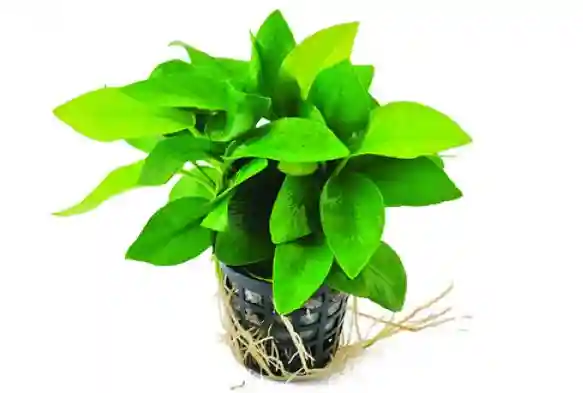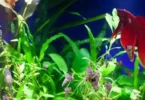Aquariums are like miniature underwater worlds, and adding plants to your aquarium can enhance its beauty, provide natural hiding spots for fish, and improve water quality. One such versatile and popular plant is Anubias, known for its unique appearance, resilience, and easy care. In this article, we’ll dive deep into the world of Anubias Aquarium Plants, covering everything from their benefits to care tips and popular varieties.
Anubias Aquarium Plants: Nature’s Aquatic Jewels

Anubias Aquarium plants are a genus of aquatic flowering plants that belong to the family Araceae. Originating from the tropical regions of Africa, these plants have gained popularity among aquarium enthusiasts due to their aesthetic appeal and ease of maintenance. Anubias plants are available in various species, each with its distinct features.
Benefits of Anubias in Your Aquarium
Adding anubias – aquarium plants to your aquatic setup offers numerous benefits:
- Natural Beauty: Anubias plants feature broad, lush leaves that come in different shades of green, providing a beautiful backdrop for your fish.
- Low Light Tolerance: Anubias can thrive in low-light conditions, making them an excellent choice for aquariums with minimal artificial lighting.
- Oxygenation: These plants contribute to the oxygenation of the water, creating a healthier environment for your fish.
- Algae Control: Anubias help control algae growth by competing for nutrients, which keeps your aquarium cleaner.
- Fish Comfort: The leaves of anubias plants provide shelter and resting places for your fish, reducing stress and promoting natural behavior.
Anubias Care Guide: Keeping Your Plants Happy
Caring for anubias – aquarium plants is relatively simple, making them ideal for beginners and experienced aquarists alike. Here are some essential care tips:
- Placement: Anchor anubias plants to driftwood, rocks, or other decor using fishing lines or plant-safe glue. Avoid burying the rhizome (the thick stem from which leaves grow) in the substrate, as this can lead to rot.
- Lighting: While anubias can thrive in low light, providing moderate lighting enhances their growth and color. LED aquarium lights with adjustable intensity are a good option.
- Water Conditions: Anubias prefer stable water parameters. Maintain a temperature between 72-82°F (22-28°C), a pH range of 6.0-7.5, and moderate water flow.
- Fertilization: Anubias are slow-growing plants with low nutrient requirements. Use a liquid fertilizer with a balanced formula, but avoid overdosing, as it can harm the plants.
- Pruning: Trim yellowing or damaged leaves to encourage new growth. Be gentle with the rhizome to prevent damage.
Popular Varieties of Anubias
- Anubias Barteri: One of the most common varieties, Anubias barteri has broad, deep green leaves that are slightly pointed. It’s available in different forms, including Anubias barteri nana, a compact version ideal for smaller aquariums.
- Anubias Congensis: This variety has elongated leaves with a unique appearance, making it a favorite among aquascapers.
- Anubias Afzelii: Known for its long, lance-shaped leaves, Anubias afzelii adds an interesting texture to your aquarium.
Anubias – Aquarium Plants Buying Tips

Plants in deep shade are dark green; light green ones thrive in well-lit farms. Monitor your tank’s light for changing shades of green. Opt for healthy plants, avoiding yellowing, soft leaves, and stems. Look for rigidity and consistent color as a sign of vitality. Anubias can be hard to assess visually, but melted plants may indicate transit issues. Consider a different source if severe melting occurs with Anubias in your tank.
Suitable Fish for Anubias – Aquarium Plants
Anubias – aquarium plants not only enhance the aesthetics of your underwater world but also provide natural shelter and hiding spots for your fish. When selecting fish to accompany your anubias plants, it’s essential to consider compatibility, behavior, and environmental needs. Let’s explore some fish species that thrive alongside anubias plants.
Peaceful Community Fish
- Neon Tetras: These tiny, vibrant fish are known for their peaceful nature and striking coloration. They coexist harmoniously with anubias plants and add a splash of color to your aquarium.
- Corydoras Catfish: With their playful demeanor and bottom-dwelling behavior, Corydoras catfish are a great addition. They won’t disturb your anubias plants and contribute to a balanced ecosystem.
Bottom Dwellers
- Bristlenose Plecos: These algae-eating plecos are excellent tank cleaners and won’t harm your anubias plants. They prefer hiding in the crevices of driftwood, which complements the plants.
- Kuhli Loaches: These slender, nocturnal fish are fascinating to watch as they explore the aquarium floor. They’re peaceful and won’t disturb your anubias plants’ roots.
Mid-Level Swimmers
- Guppies: Guppies come in a variety of colors and patterns, making them a popular choice for community tanks. They’re active swimmers and won’t interfere with your anubias plants.
- Swordtails: With their distinct sword-like tails, these fish add elegance to your aquarium. They’re generally peaceful and won’t pose a threat to your anubias plants.
Invertebrates
- Cherry Shrimp: These small, colorful shrimp are not only delightful to watch but also help clean up algae in your tank. They peacefully coexist with anubias plants.
- Nerite Snails: Nerite snails are efficient algae eaters and won’t damage your anubias plants. They’re a valuable addition to a balanced aquatic ecosystem.
Cautions
While many fish are compatible with anubias – aquarium plants, it’s important to avoid species that are notorious for nibbling or uprooting plants. Fish like certain types of goldfish and some cichlids can pose a threat to the well-being of your anubias plants. Always research the specific requirements and behaviors of fish before adding them to your tank.
Remember, creating a harmonious environment for both your fish and anubias plants ensures a thriving and visually appealing aquarium. Choose fish that align with the peaceful and low-maintenance nature of anubias, and enjoy the beauty they collectively bring to your aquatic haven.
Does Anubias need to be planted?
Anubias, or aquarium plants, possess a unique characteristic that sets them apart from many other aquatic plants: they don’t necessarily need to be planted in the traditional sense. In fact, planting Anubias by burying their rhizomes (the thick stems from which leaves grow) in the substrate can lead to issues rather than benefits.
Anchoring, Not Burying: Instead of planting Anubias by burying their rhizomes in the substrate, it’s recommended to anchor them to aquarium decors such as driftwood, rocks, or other structures. The rhizome should be exposed and above the substrate. This method mimics their natural growth habits in the wild, where they often attach themselves to surfaces along the water’s edge.
Benefits of Anchoring: Anchoring Anubias plants offers several advantages:
- Prevents Rot: Burying the rhizome can lead to rot, as it’s not adapted to being buried. Anchoring prevents this risk.
- Promotes Growth: Exposing the rhizome to light and water flow encourages healthy growth and prevents decay.
- Natural Look: Anchored Anubias plants provide a more natural and aesthetically pleasing appearance in your aquarium.
How to Anchor Anubias?
- Choose suitable aquarium decor, such as driftwood or rocks.
- Gently tie or attach the Anubias rhizome to the chosen surface using a fishing line or plant-safe glue.
- Ensure the rhizome is above the substrate and not buried.
By anchoring your Anubias plants rather than planting them, you’re providing the optimal conditions for their growth and well-being. This approach maintains the health and beauty of these wonderful aquatic additions to your tank.
Growing Anubias Emersed
Emersed Growth: Growing Anubias—aquarium plants—emersed refers to cultivating them in a terrestrial environment rather than fully submerged underwater. This method can be beneficial for certain purposes, such as propagation, plant health, or preparing for a transition to an aquatic setting.
Advantages of Emersed Growth
- Faster Growth: Emersed growth can lead to faster growth rates compared to their submerged counterparts.
- Less Algae: Emersed setups often have lower algae levels, which can be advantageous during certain stages of plant development.
- Propagation: Emersed cultivation is ideal for propagating Anubias through division. It encourages the development of new shoots and leaves.
Creating an Emersed Setup
- Container: Use a shallow container or tray to hold the growing medium and plants. Ensure it has drainage holes.
- Substrate: Choose a suitable substrate, such as a mixture of potting soil and inert material like sand or gravel.
- Planting: Gently plant the Anubias rhizomes into the substrate, leaving the rhizomes exposed.
- Humidity: Maintain high humidity levels in the environment, ideally by covering the container with a clear lid or plastic wrap.
- Lighting: Provide bright, indirect light to stimulate growth. A mix of natural sunlight and artificial lighting can work well.
- Watering: Keep the substrate consistently moist but not waterlogged. Avoid standing water.
Transition to Submerged Aquarium: When transitioning emersed-grown Anubias back to a submerged aquarium, it’s crucial to acclimate them gradually. Submerge the plants partially at first, allowing them to adjust to the underwater conditions over a few days to prevent shock.
Emersed Growth Challenges: While emersed growth offers advantages, it also presents challenges, such as the need for consistent humidity and careful acclimation during the transition. Additionally, some Anubias varieties may not adapt well to emersed cultivation.
Growing Anubias emersed can be a rewarding experience, whether you’re aiming for quicker growth, and propagation, or preparing for a transition to an aquatic environment. This method requires careful attention to humidity, lighting, and acclimation to ensure the success of your emersed cultivation.
Choosing the Right Aquarium Plant Substrate for Anubias
Selecting the right aquarium plant substrate is vital for the health and growth of your Anubias – aquarium plants. While Anubias are known for their ability to thrive in various conditions, providing them with a suitable substrate can enhance their well-being and overall aesthetic appeal in your aquatic setup.
Importance of Substrate: Aquarium plant substrates serve multiple purposes, including anchoring plants, providing essential nutrients, and promoting a balanced ecosystem. An ideal substrate supports root development, aids in nutrient absorption, and contributes to water quality.
Factors to Consider
- Nutrient Content: Anubias plants have relatively low nutrient requirements. Choose a substrate that provides essential nutrients without causing excessive growth, which can lead to unwanted algae issues. Substrates enriched with minerals and trace elements are beneficial.
- Particle Size: Opt for a substrate with a particle size that allows water circulation while preventing compaction. A mix of fine and coarse particles can provide a balanced structure.
- pH Buffering: Some substrates offer pH buffering capabilities, which can help maintain stable water parameters. Anubias typically prefer a pH range of 6.0-7.5.
- Inert vs. Active: Inert substrates like sand or gravel won’t alter water chemistry, making them suitable for low-maintenance setups. Active substrates like nutrient-rich soil can benefit more demanding plants in the same tank.
- Anchoring: Since Anubias rhizomes shouldn’t be buried, choose a substrate that allows you to anchor them to the decor without causing damage.
Suitable aquarium plant Substrate Options:
- Sandy Substrate: Anubias plant can thrive on a sandy substrate. It allows for easy anchoring and is compatible with their low-light preferences.
- Gravel Substrate: Gravel provides stability for anchoring while allowing water circulation. Choose a size that prevents the rhizomes from sinking into the substrate.
- Aquatic Plant Soil: For a nutrient-rich option, aquatic plant soil can provide essential minerals and support root growth. Mix it with inert materials to prevent excessive nutrient levels.
Aquarium Plant Substrate Preparation
- Rinse: Rinse the substrate thoroughly to remove dust and debris before adding it to your aquarium.
- Layering: Create a substrate layer of around 2-3 inches in depth to accommodate root growth. Consider layering with nutrient-rich soil beneath inert gravel for enhanced plant health.
- Arrangement: When placing Anubias, ensure their rhizomes are exposed and not buried. Anchor them to decor above the substrate.
Choosing the right substrate for your Anubias plants plays a significant role in their overall health and growth. Consider the specific needs of your aquarium setup and the preferences of your plants to create an environment where your anubias can thrive and contribute to the beauty of your underwater world.
Conclusion
Anubias aquarium plants are a fantastic addition to any aquatic setup, bringing beauty and vitality to your underwater world. Their easy care and versatility make them a favorite among aquarists of all skill levels. Whether you’re a beginner looking to enhance your aquarium’s aesthetics or an experienced hobbyist seeking a resilient plant, anubias plants are a wonderful choice. Explore the different varieties, follow our care guide, and enjoy the lush greenery that anubias brings to your aquatic haven.
FAQs about Anubias Aquarium Plants
Are anubias plants suitable for beginners?
Yes, anubias plants are excellent for beginners due to their low maintenance requirements.
Can I propagate anubias plants?
Yes, you can propagate anubias by dividing the rhizome, ensuring each division has leaves and roots.
Do anubias plants require CO2 injection?
No, anubias can grow well without CO2 injection, but it can boost their growth.
Why are the leaves of my anubias turning yellow?
Yellowing leaves could be due to nutrient deficiencies, inadequate lighting, or poor water quality. Address these issues to keep your plants healthy.
Can anubias plants survive in brackish water?
While anubias plants are primarily freshwater plants, some species can tolerate slightly brackish water conditions, but it’s best to keep them in freshwater environments.
Are anubias plants safe for fish and shrimp?
Yes, anubias plants are safe for fish and shrimp, providing them with natural habitats and hiding spots.
Is Anubias easy to grow?
Yes, Anubias is considered one of the easiest aquatic plants to grow. Their hardy nature and slow growth rate make them low-maintenance. They can thrive in a variety of water conditions and lighting levels. It’s essential to avoid burying the rhizome (thick stem) in the substrate to prevent rot. Anchoring the plants to decor, like driftwood or rocks, is the preferred method of planting.
Is Anubias good for aquariums?
Absolutely! Anubias – aquarium plants are fantastic additions to your aquatic setup. They not only add natural beauty and vibrancy to your tank but also provide shelter and hiding spots for your fish. Their low-light tolerance and easy care make them suitable for beginners and experienced aquarists alike.







Leave a Comment
You must be logged in to post a comment.